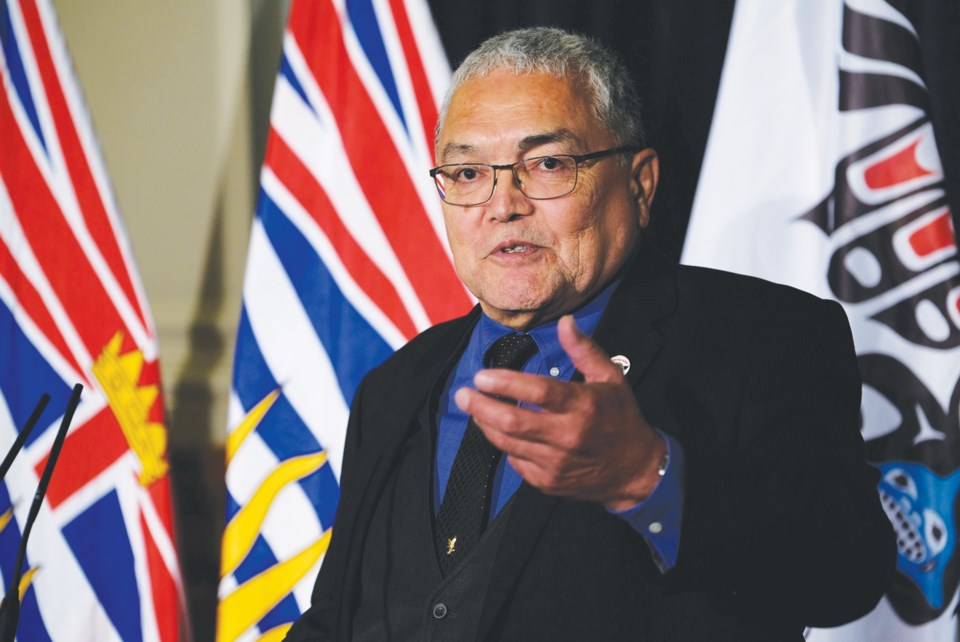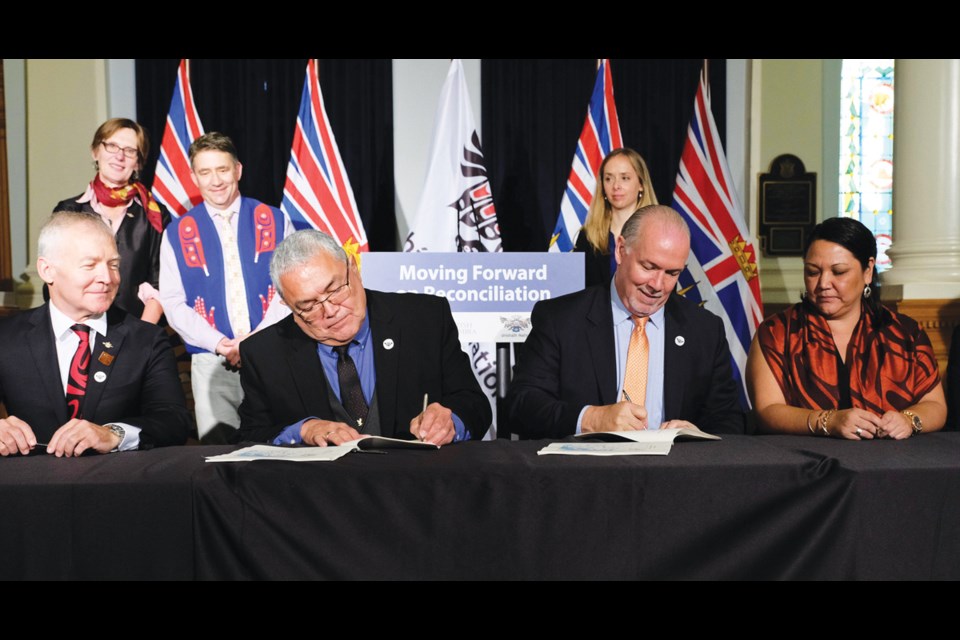After 23 months of negotiating, the shíshálh Nation and the province have signed the first major reconciliation agreement of its kind between the government and an Indigenous community.
The agreement is a “completely new model for true reconciliation in British Columbia,” said shíshálh Nation Chief Warren Paull. He said it “will set the foundation for the next 25 years,” and that the agreement pushes past “obstacles that have caused massive delay, conflict and contention in the past.”

Paull and members of shíshálh Nation council, Premier John Horgan and several ministers attended the Oct. 4 signing in Victoria, which was witnessed by Sunshine Coast-Powell River MLA Nicholas Simons. Also present were representatives from Lehigh Hanson Materials and Interfor, and more than 50 shíshálh community members, stakeholders and politicians.
“The foundation of this agreement will set the course for shared decision making on land use in shíshálh territory. It will establish land use planning processes and effective consultation on resources, particularly forestry, in shíshálh territory, and it will be the beginning of relationships across cultures and across communities,” Horgan said at the signing.
Following the signing, Simons told Coast Reporter, “Shíshálh Nation was the first with self-government in 1986, and they are first again. This is new territory for government-to-government agreements, and both parties will ensure the process works for everyone.”
Under the agreement, a set of “new decision-making structures” will establish a government-to-government working relationship between shíshálh Nation and the province. For example, built into the agreement are joint implementation and advisory committees, Paull told Coast Reporter after the ceremony. A “very robust” dispute mechanism has also been built into the agreement.
The province will provide $36 million to shíshálh Nation to support land purchases and the cost of implementation.
Included in the agreement are land transfers, economic and socio-cultural investments, and “joint aspirational long-term commitments,” according to a release from the Ministry of Indigenous Relations and Reconciliation.
The Crown will transfer three parcels of land near existing land owned by shíshálh that will be used for “economic development purposes, including gravel extraction, as well as for social and cultural purposes,” said the release. The land will be in addition to parcels that were identified to be transferred in a 2016 reconciliation agreement. “Before any of the new land transfers are finalized, the Province and shíshálh will continue to work with all stakeholders, including industry, permit and tenure holders and local governments, to address their interest in the lands,” said Ministry of Indigenous Relations communications director Sarah Plank in an email.
Another new item is a Shared Decision Making Pilot Agreement for forestry decisions in the region. “If successful, we can expand to other land-based decisions for other sectors,” said Doug Donaldson, Minister of Forests, Lands, Natural Resource Operations and Rural Development, who added that the model could also be used in other regions of the province.
Donaldson said the shared decision-making board would consist of up to three representatives each from the province and shíshálh Nation. It will also allow for greater participation of shíshálh Nation in the forestry sector.
Additionally, the ministry has committed to a “Land Use Planning Table” that will review completed land use studies and offer information that could contribute to a joint land use plan between shíshálh Nation and the province.
The reconciliation agreement may be new in form, but it comes off the back of three agreements that were signed in 2016: an interim forestry agreement, a government-to-government agreement and a reconciliation agreement. That agreement announced the transfer of 288 hectares of Crown land to shíshálh Nation, an annual share of provincial forestry revenue of approximately $480,000 and $100,000 in capacity funding provided by the province.
The land to be transferred as fee simple included 148 hectares at the top of Narrows Inlet, 100 hectares at the southwest mouth of Salmon Inlet and 40 hectares on the west side of Sechelt Inlet. One of those parcels near Egmont was transferred in March 2018 and work is ongoing to transfer the parcels at Narrows Inlet and Salmon Inlet, with expected completion in 2019.
At the time, that reconciliation agreement was called an “initial stepping stone” by then Minister of Aboriginal Relations and Reconciliation John Rustad.
At the Oct. 4 signing, Horgan told the audience, “The moment in history for genuine reconciliation is before us all. The opportunity cannot be missed. Today is a symbol of that first step and to the shíshálh Nation, I thank them for their patience and for their endurance through very difficult times.”
Paull said the 25-year agreement is based on a five-year renewal. “We’re hoping that 25 years is only the first installment because our idea is we want to work in collaboration with the Crown for as long as they want to work with us.”



